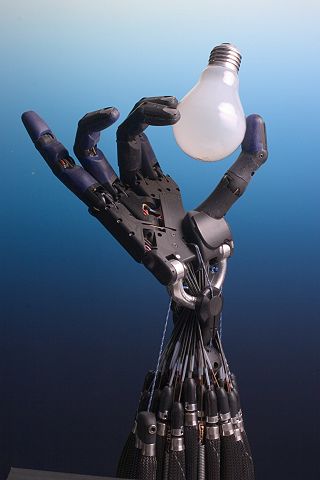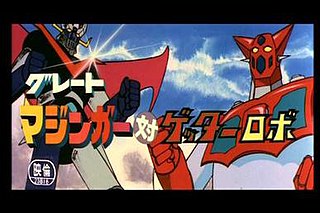Related Research Articles
An autonomous robot is a robot that acts without recourse to human control. The first autonomous robots environment were known as Elmer and Elsie, which were constructed in the late 1940s by W. Grey Walter. They were the first robots in history that were programmed to "think" the way biological brains do and meant to have free will. Elmer and Elsie were often labeled as tortoises because of how they were shaped and the manner in which they moved. They were capable of phototaxis which is the movement that occurs in response to light stimulus.
Robotic control is the system that contributes to the movement of robots. This involves the mechanical aspects and programmable systems that makes it possible to control robots. Robotics could be controlled in various ways, which includes using manual control, wireless control, semi-autonomous, and fully autonomous. In the present day, as technological advancements progress, robots and their methods of control continue to develop and advance.
Robot locomotion is the collective name for the various methods that robots use to transport themselves from place to place.

CryEngine is a game engine designed by the German game developer Crytek. It has been used in all of their titles with the initial version being used in Far Cry, and continues to be updated to support new consoles and hardware for their games. It has also been used for many third-party games under Crytek's licensing scheme, including Sniper: Ghost Warrior 2 and SNOW. Warhorse Studios uses a modified version of the engine for their medieval RPG Kingdom Come: Deliverance. Ubisoft maintains an in-house, heavily modified version of CryEngine from the original Far Cry called the Dunia Engine, which is used in their later iterations of the Far Cry series.
In video games, artificial intelligence (AI) is used to generate responsive, adaptive or intelligent behaviors primarily in non-player characters (NPCs) similar to human-like intelligence. Artificial intelligence has been an integral part of video games since their inception in the 1950s. AI in video games is a distinct subfield and differs from academic AI. It serves to improve the game-player experience rather than machine learning or decision making. During the golden age of arcade video games the idea of AI opponents was largely popularized in the form of graduated difficulty levels, distinct movement patterns, and in-game events dependent on the player's input. Modern games often implement existing techniques such as pathfinding and decision trees to guide the actions of NPCs. AI is often used in mechanisms which are not immediately visible to the user, such as data mining and procedural-content generation.

BigDog is a dynamically stable quadruped military robot that was created in 2005 by Boston Dynamics with Foster-Miller, the NASA Jet Propulsion Laboratory, and the Harvard University Concord Field Station. It was funded by DARPA, but the project was shelved after the BigDog was deemed too loud for combat.
Modular self-reconfiguring robotic systems or self-reconfigurable modular robots are autonomous kinematic machines with variable morphology. Beyond conventional actuation, sensing and control typically found in fixed-morphology robots, self-reconfiguring robots are also able to deliberately change their own shape by rearranging the connectivity of their parts, in order to adapt to new circumstances, perform new tasks, or recover from damage.

Legged robots are a type of mobile robot which use articulated limbs, such as leg mechanisms, to provide locomotion. They are more versatile than wheeled robots and can traverse many different terrains, though these advantages require increased complexity and power consumption. Legged robots often imitate legged animals, such as humans or insects, in an example of biomimicry.
The Battlefield Extraction-Assist Robot (BEAR) is a remotely controlled robot developed by Vecna Robotics for use in the extraction of wounded soldiers from the battlefield with no risk to human life. The humanoid robot uses a powerful hydraulics system to carry humans and other heavy objects over long distances and rough terrain, such as stairs.
Boston Dynamics is an American engineering and robotics design company founded in 1992 as a spin-off from the Massachusetts Institute of Technology. Headquartered in Waltham, Massachusetts, Boston Dynamics has been owned by the Hyundai Motor Group since December 2020, but having only completed the acquisition in June 2021.
Mecha anime and manga, known in Japan as robot anime and robot manga, are anime and manga that feature robots (mecha) in battle. The genre is broken down into two subcategories; "super robot", featuring super-sized, implausible robots, and "real robot", where robots are governed by realistic physics and technological limitations.

Robot localization denotes the robot's ability to establish its own position and orientation within the frame of reference. Path planning is effectively an extension of localisation, in that it requires the determination of the robot's current position and a position of a goal location, both within the same frame of reference or coordinates. Map building can be in the shape of a metric map or any notation describing locations in the robot frame of reference.
D* is any one of the following three related incremental search algorithms:

Robotics is an interdisciplinary branch of computer science and engineering. Robotics involves design, construction, operation, and use of robots. The goal of robotics is to design machines that can help and assist humans. Robotics integrates fields of mechanical engineering, electrical engineering, information engineering, mechatronics, electronics, bioengineering, computer engineering, control engineering, software engineering, mathematics, etc.

Grendizer, Getter Robo G, Great Mazinger: Kessen! Daikaijuu is an animated short film produced by Toei which premiered originally on July 18, 1976, in Japan. It is a crossover of three super robot anime: Grendizer, Getter Robo G and Great Mazinger. Like the rest of the Vs. animated films of Toei, the movie features alternate versions of events from the three series and is not canonical to any of them. The film was released in almost all countries where the original Grendizer series was broadcast. It is known as Il Grande Mazinga, Getta Robot e Goldrake contro il Dragosauro in Italy and Goldorak: L'attaque du Dragosaure in France and some parts of Canada.

Great Mazinger vs. Getter Robo is an animated short film produced by Toei based in the works of Go Nagai and Ken Ishikawa. The film premiered originally in March 21, 1975 in Japan. It is a crossover between the super robot anime Great Mazinger and Getter Robo, similar to the previous crossover film Mazinger Z vs. Devilman. The events presented in the film are not considered canon to either of the two series.

Great Mazinger vs. Getter Robo G: Kuchu Daigekitotsu is an animated short film produced by Toei Doga. It is a crossover anime between Great Mazinger and Getter Robo G. It was originally shown in theaters along with Uchu Enban Daisenso. They both premiered in July 26, 1975 in Japan.
Surena is a series of Iranian humanoid robots, named after the Parthian General Surena. The Institute of Electrical and Electronics Engineers (IEEE) has placed the Surena among prominent robots in the world after analyzing its performance.
Atlas is a bipedal humanoid robot primarily developed by the American robotics company Boston Dynamics with funding and oversight from the U.S. Defense Advanced Research Projects Agency (DARPA). The robot was initially designed for a variety of search and rescue tasks, and was unveiled to the public on July 11, 2013.

Roland Siegwart, is director of the Autonomous Systems Lab (ASL) in Switzerland, of the Institute of Robotics and Intelligent Systems at ETH Zurich and a known robotics expert.
References
- ↑ Faragalli, M.; Pasini, D.; Radziszewski, P. (2011). "A Parametric study and experimental testing of lunar-wheel suspension on dynamic terrainability". Canadian Aeronautics and Space Journal. 57 (1): 65–74. Bibcode:2011CaASJ..57...65F. doi:10.5589/q11-011.
- ↑ Nof, Shimon Y., ed. (1999). Handbook of industrial robotics (2. ed.). New York [u.a.]: Wiley. pp. 151–152. ISBN 978-0-471-17783-8 . Retrieved 16 June 2014.
